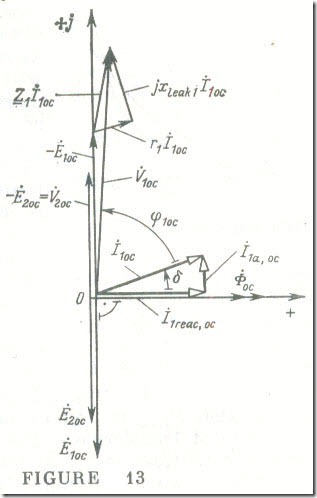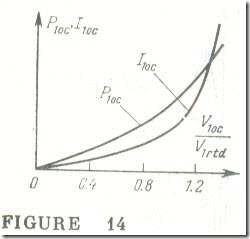The Open-Circuit Condition of a Transformer
In the open-circuit condition (Fig. 12) a transformer is effectively turned into an iron-cored coil whose winding w1 is connected across a source of a Sinusoidal voltage. For this reason, the phasor diagram for a transformer in the open-circuit condition (Fig. 13) is not unlike that of an iron-cored coil (see Fig. 8), differing, as it does, only in some symbols and in the added secondary emf phasor Ė2,0C .
The open-circuit condition is used for testing purposes in which case it is known as the open-circuit test (or the core loss and magnetizing-current test). In this form of test, the normal rated voltage, Vl,oc = V1,rtd , is applied to the primary winding, while the secon- dary winding is open-circuited. On the basis of the test data, one finds the turns (or transformation) ratio and the core losses. The open-circuit test is one of the mandatory tests carried out at the maker’s works on a finished transformer.
When the voltage applied to the primary is V1,OC = Vl,rtd, the open-circuit current I1,OC is anywhere between 3 % and 10%
of the rated primary current Il,rtd (this value being the lower, the higher the apparent power rating of the transformer). So, by Eq. (8.11a), V1,OC ≈ E1,OC . Also, when the secondary winding is open circuited, V2,OC = E2,OC Therefore, once V1,OC and V2,OC are measured with a voltmeter, it is a simple matter to find the transformation (turns) ratio
n21 = w2/w1 = E2,oc/ E2,oc
= V2,OC/V1,OC (8.13)
The transformation (or turns) ratio is indicated on the nameplate of each transformer as the ratio of the rated voltages at no-load, such as "6000/230 V".
The losses in the open-circuit condition are the sum of the core losses and the losses in the primary winding, rl/I21,oc. However I1,oc is only a small fraction of Il,rtd , so the second term in the sum of losses is negligible in comparison with the core losses (except, perhaps, for transformers rated at less than 1000 V A). This is the reason why the test is referred to, among other things, as the core loss test.
The core losses in the open-circuit conditions are small. For transformers rated at 5-50 kV A, they are a mere 0.9-1.4% of the rated power. For transformers rated at 1-10 MV A the figure is as low as 0.3-0.5 %. Nevertheless, the core losses are an important factor because power transformers are disconnected from power lines only seldom.
The open-circuit, or magnetizing, current İ1,oC . is, as is the case with an iron-cored coil, a sum of two components, one active, İ1a,oc, and the other reactive, I1reac,oc . The active component is associated with hysteresis and eddy currents and stray losses These include losses due to the vibration of core lamina Lions at the joints and around the bolts due to variations in induction, losses in structural parts due to the leakage flux , etc. The total is 15-20 % of the overall core losses. It is useful .
to remember that in most cases I1a.oc is less than 0.1 I1reac.oc , so it is legitimate to take it that the magnetizing current is practically in quadrature lagging with the primary voltage, that is, φ1.oc ≈ π/2 (see Fig. 13).
The core loss and magnetizing current test as described above is the principal form of test in the open-circuit condition. In some cases, however, such as when the cooling capability is limited it is important to know how the open-circuit condition will change due to changes in the primary voltage. The relations thus obtained, P1.oc=f (V1,oe) and I1,oc = F(Vl,oc) are called the open-circuit characteristics of a transformer (Fig. 14). At the beginning of this test the primary voltage is zero. As it is gradually raised, I1,oc is rising at first (so long as the core is ,not saturated) in proportion to the applied voltage. Some time later, the core reaches saturation (this happens at approximately V1,oc > 0.8 V1,rtd), and I1,oc builds up rapidly.
The core losses are proportional to B2 (see Eq. (7.11) and Eq. (7.12) , and, as a consequence, to Φ2. Since the rms emf E1,oc is proportional to Φ = Φm/√2 (see Eq. (8.1a) and E1,oc ≈ Vl,oc , it follows that P1,oc is proportional to V21,oc .
For most transformers, the upper limit of voltage in the open circuit condition is 1.1 of the rated voltage, which fact must be remembered when experimenting with transformers.



